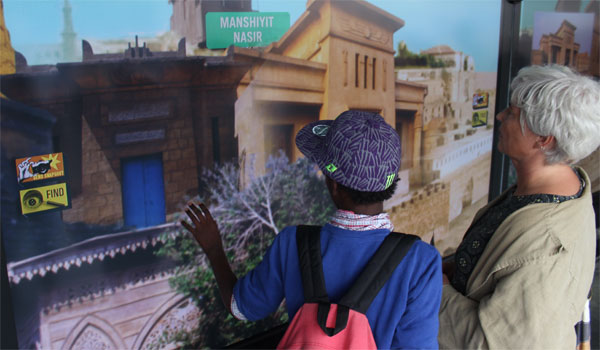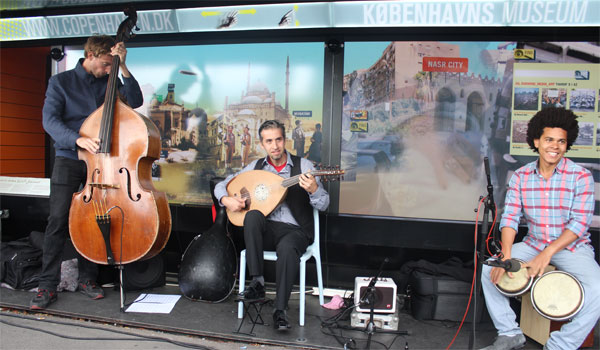Between 30 August and 21 September, the WALL, a well known Copenhagen installation, is transformed to Sanduq El-Dunia to present images from Cairo, introducing viewers to the history, culture and heritage of the Egyptian capital.
The WALL is a multi-user multi-touch interface project launched by the Museum of Copenhagen in association with Gibson International and Spild af Tid/Waste of Time. This 12 metres long and two metres high installation is located at one side of the Queen Louise Bridge in the Nørrebro district of Copenhagen, Denmark. It consists of four plasma screens where viewers are able to travel through a large archive of images evoking the city of Copenhagen and its history by touching the screen. They can also log in to the interface and upload their own photos.
"Until the launch of the WALL back in 2010, the Museum of Copenhagen was a rather traditional museum. We needed to have a project that would take art and creativity to a different level and would approach to the public in the city, in the urban spaces. The WALL is also a way to present content we have in our archives without using verbal language. The map is a very analytical approach to the city, while the WALL allows the audience to become intuitive in their navigation through the experimental cityscape presented by the project," Jette Sandahl, director of the Museum of Copenhagen, explained to Ahram Online.
On Friday, 30 August, the WALL replaced the thousands of images representing Copenhagen with images from Cairo. Called Sanduq El-Dunia, the installation presents images from Egypt's capital, bringing to the viewer the city's history, memory and heritage.

Photo: Ati Metwaly
Sanduq El-Dunia is the result of cooperation between the Danish-Egyptian Dialogue Institute (DEDI), the Museum of Copenhagen and a number of cultural institutions in Cairo.
"During one of the visits of DEDI to Copenhagen, they saw the WALL and thought they'd love to create the same thing in Cairo," Sandahl explains. "Sanduq El-Dunia as presented in Copenhagen is a sort of a pilot project for a bigger plan that will eventually lead to reproducing it for the Egyptian public."
Mona Bur, DEDI programme officer and one of those responsible for handling Sanduq El-Dunia, clarifies that the idea of having the similar installation in Egypt came right after January 2011 revolution. "During the first 18 days of the revolution, and in the following months, we were thinking about the relationship with the Egyptian street. We looked into the new artistic media emerging from Tahrir Square along with many fascinating stories and images," Bur explained to Ahram Online.
"We were inspired by the guiding principles behind the WALL, namely cultural democracy, citizens' participation and taking the medium to the street — 'culture for all,' a concept that we admire very much," Bur adds.
Bur says that it is still not clear where such an installation would be located in Cairo, though several suggestions are already on the table. "We look into public and semi-public sites. We also have to put in mind that the wall will have to adapt to local circumstances in terms of content, climate, pollution, etc."
While plans for placing a similar wall in Cairo are still in the pipeline, Copenhagen inhabitants can now experience a journey through Cairo and engage in the complexities and paradoxes of the city, its profound historical and cultural heritage, and changing identity.
On 30 August, a large number of Copenhageners, tourists and many members of the Arab community attended the official opening during which event organisers introduced the audience to the project while Bilal's Trio — an oud player from Palestine, a drummer from Cuba and a double bass player from Denmark — added musical accents.
Viewers were then invited to experiment with the images uploaded to the installation's interface. The collection consists of a large number of digitised photographs from many sources in Egypt, such as CULTNAT (the Centre for Documentation of Cultural and Natural Heritage), universities, several cultural institutions as well as individuals that were eager to share images.

Photo: Ati Metwaly
"It feels richer in a way than material that we have in Denmark's WALL. This is partially due to the headlines that we worked on, from architecture to street culture, from advertisement elements to personalised photography. As such we have a mixture of formal and informal culture — images that actually represent what is really happening in the city's life. When combined, those two cultures coexist very successfully on the wall. Cairo is definitely more vibrant, as the city has more people and a larger cultural versatility," Sandahl says, adding that many personal photographs are featured, connecting the display to real lives.
As with the Copenhagen WALL, viewers are able to upload their own photos to Sanduq El-Dunia, add a description and comment. Users are free to manage the content. The interface filters any obscene language.
The opening evening attracted viewers from many cultural backgrounds and generations. Young children and their parents scrolled through the images. "Look, this is the Sphinx ... here are the Pyramids ... " viewers would comment. A group of Egyptians seemed to be excited about specific districts — Agouza, Maadi, Dokki etc — that triggered personal memories.
"The shift to presenting Cairo is a very interesting initiative," comments Danish young man. "I've never been to Egypt and all we know about it is ancient history. Now we are getting glimpses about its current politics and upheaval, via media channels. It's fascinating to have a sneak peek into the actual city and its people."
"I recognise many areas," an Egyptian man who moved to Denmark a few years ago comments to Ahram Online. "It's a very nostalgic experience ... "
****
The installation's launch parallels this year's Images Festival, one of Scandinavia’s biggest arts and culture festivals held bi-annually since the early 1990s. However, while the Images Festival runs until 7 September, Sanduq El-Dunia extended its closing date to 21 September.
Sanduq El-Dunia is developed by DEDI and its partners: Museum of Copenhagen, CULTNAT and the Women and Memory Forum (WMF). The organisers also cooperate with a number of cultural institutions, architects, artists and individuals.
The Copenhagen WALL won several awards, such as the 2012 United Nations World Summit Award, the eContent and Creativity Award, the 2012 Gold Award of the Interacive Kiosk category in the MUSE Awards presented by the American Association of Museums, and the 2012 Jim Blackbay Ingenuity Award from American Association of Museums.

Bilal's trio perform at the opening of Sanduq El-Dunia installation, 30 August 2013, Copenhagen, Denmark (Photo: Ati Metwaly)
Short link: